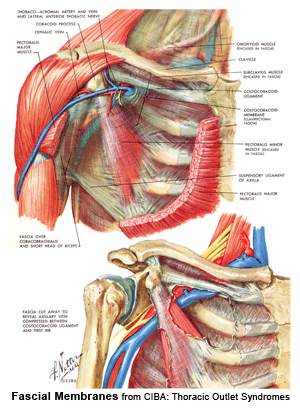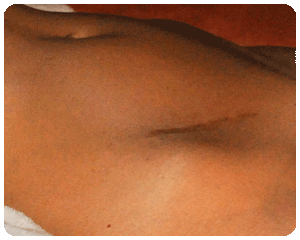Fascia and Scar Tissue Release
 Another important, but neglected system of the body is the connective-tissue (sidekudos) fascial system. Fascia is a thin membrane or sheet of tissue whilch surrounds, covers and connects all tissues and organs of the body- muscles, bones, nerves, blood vessels, and internal organs- everything. It is like a netting of tightly woven connective-tissue which ‘holds everything together’ and allows independent movement between tissue layers. It is not highly elastic like muscle tissue. Fascia becomes tight and restrictive due to poor posture, scoliosis, trauma, repetitlive strain, chronic inflammation and surgical scars. Once an area of fascia becomes tight and short with adhesion formation the restrictions spread to other areas of the body creating further mechanical imbalances. Fascial restrictions range form microscopic adhesions at the cellular level to macroscopic adhesions forming overt scar tissue. In all cases there is movement restriction at the tissue level which can be detected with skilled palpation.
Another important, but neglected system of the body is the connective-tissue (sidekudos) fascial system. Fascia is a thin membrane or sheet of tissue whilch surrounds, covers and connects all tissues and organs of the body- muscles, bones, nerves, blood vessels, and internal organs- everything. It is like a netting of tightly woven connective-tissue which ‘holds everything together’ and allows independent movement between tissue layers. It is not highly elastic like muscle tissue. Fascia becomes tight and restrictive due to poor posture, scoliosis, trauma, repetitlive strain, chronic inflammation and surgical scars. Once an area of fascia becomes tight and short with adhesion formation the restrictions spread to other areas of the body creating further mechanical imbalances. Fascial restrictions range form microscopic adhesions at the cellular level to macroscopic adhesions forming overt scar tissue. In all cases there is movement restriction at the tissue level which can be detected with skilled palpation.
Skilled Palpation Demanded
 These restrictions are often very subtle, they can be difficult to detect, and therefore demand a highly developed sense of touch to locate and interpret them. Equally subtle are some of the manual treatment techniques which stretch and release these adhesions. Again, a high level of manual skill is required to detect and treat fascial restrictions. The manual techniques are quilte unlike those used for treating muscles and joints; rather, the adhesion-releasing techniques are performed very slowly and gently over relatively long periods of time. The results, though, are usually immediately apparent and often dramatic. Significant changes in both pain levels and improvements in mobility are often immediate and long-lasting.
These restrictions are often very subtle, they can be difficult to detect, and therefore demand a highly developed sense of touch to locate and interpret them. Equally subtle are some of the manual treatment techniques which stretch and release these adhesions. Again, a high level of manual skill is required to detect and treat fascial restrictions. The manual techniques are quilte unlike those used for treating muscles and joints; rather, the adhesion-releasing techniques are performed very slowly and gently over relatively long periods of time. The results, though, are usually immediately apparent and often dramatic. Significant changes in both pain levels and improvements in mobility are often immediate and long-lasting.
Fascial Linkage System
In our experience at Bliss Clinic, comprehensive treatment of pain must include analysing and treating the fascial system in addition to the more familiar treatments of joints, muscles and bones. All tissues are designed to function in synchrony and fascia is the main ‘connective-tissue’ which links them all. Detecting faults in this linkage system is another highly important but often seriously neglected part of successsful pain management.
Scar Tissue and ‘Toxic’ Scars

Appendix Scar
Treating scar tissue is a specialized form of fascial-tissue treatment. Scars result from the injury of wounds and broken bones as well as a consequence of surgery anywhere in the body. Scars are a natural consequence of healing and repairing damaged tissue. However, they may create problems in their own right, especially when scar tissue formation is excessive or when the scar causes multiple layers of tissue to adhere or weld together, thus disturbing the normal mobility of these structures. These restrlictive scars cause abnormal tissue tension which leads invariably to pain, sometimes locally and often at a distant sites.
Treating Surgical Scars

Abdominal Scar
These, so-called, ‘toxic’ scars can interfere with healing and the functioning of the body in many different ways. They may have been present since childhood. For example, scars from abdominal surgery (appendectomy, hysterectomy, C-section, hernia etc) can perpetuate not only various abdominal pains and organ problems but also can contribute, through abnormal fascial tensions, to neck, low back and postural problems. Sometimes by releasing an old, assymptomatic, surgical scar in the abdomen region, a pain problem in the spine of many years duration finally goes away. Without that one small, but critically important, aspect of treatment- scar release-, the pain problem in question is never completely resolved. Scars are always important to examine and treat properly in cases of chronic pain. Seldom is the pain and the scar located in the same place. This is the challenge diagnostically. Thus, a comprehensive examination in the hands of skilled manual therapists is essential.
Emotional Pain from Scars

Surgical Appendix Scar
Interestingly too, it has been observed that ‘toxic’ scars can be a repository of negative emotions, that is, old negative emotions can somehow be ‘locked up’ in the scar tissue web. It is theorized that negative emotions or memories -excessive fear, anger, sorrow- which were experienced at the time of tissue trauma (from injury or surgery) can interfere with normal tissue repair, thus leading to abnormal and harmful (toxic) scar tissue formation. In some way these scars retain a ’tissue-memory’ of the negative emotion or negative event.
Sometimes, during the course of treating scars and restrictive fascia, old negative emotions and memories suddenly rise to the surface and their negative energy is released- a catharsis, of sorts, takes place or sometimes the patient gets a new ‘insight’ about something important. This seems to have positilve effect not only on their chronic pain problem itself but also on their psyche. Some ‘burden’ seems to be lifted off which the patient invariably construes as a useful and positive thing. Clinically, we see it in the same light.
These ’emotional releases’ do not happen very often, nor can their occurance be predicted with any great accuracy. They happen when they happen. But they do remind us that the mind, emotions and body can never be separated. And, that we must respect the person, the person in pain, for the multi-dimensional being that they are.
